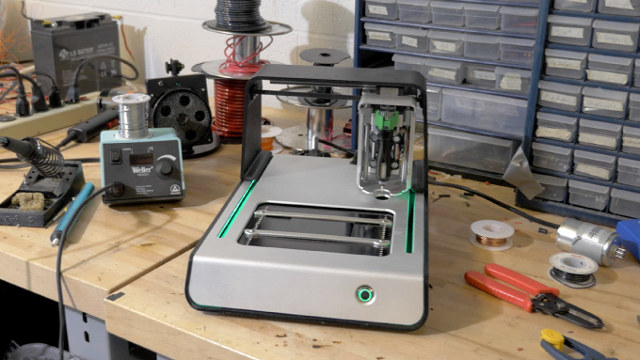The traditional hardware development cycle involve sending PCB Gerber files to a manufacturer, wait a few days (or weeks), get the boards back, find and fix bugs, send a new revision of the gerber files to the manufacturer and so on. This wastes a lot of time, so PCB printers capable of handline single and dual layer PCBs have started to see the light of the day, for example with BotFactory Squink. The latter can also do pick and place, but costs over $3,500. Luckily if you’d like something cheaper, Voltera V-One will do many of the same tasks, for but for only $1,500.
- Minimum Trace Width – 8mil (~0.2mm)
- Minimum Passive Size – 0603 (0402 for solder paste)
- Minimum Pin-to-Pin Pitch – 0.8mm (0.5mm for solder paste)
- Resistance – >12 mOhm/sq @ 70um height
- Max Heated Bed Temperature – 250C
- Heated Bed Ramp Rate – ~2C/s
- PC Connection – USB
- Print area – 138 x 102 mm
- Board Substrate – FR4; max thickness: 3mm (~1/8″)
- Recommended Solder Wire Alloys – Sn62, SAC305
- Recommended Solder Paste Alloys -Sn42/Bi58, Sn63/Pb37
- Dimensions – 390 x 257 x 207 mm
- Weight – ~7kg
So instead of sending the Gerber files to the manufacturer, you’d send them to the printer via USB, and get a board within one hour and a half (exact time depends on actual PCB). Currently, only Gerber files generated with EAGLE, Altium, Upverter, and KiCad are supported. The software only runs on Windows for now, but Linux and OSX version should be available once the PCB printers ship.
If your PCB needs hole, you’ll have to do that manually. The company also plans to provide expansion board templates for popular development boards starting with Arduino UNO and Mega shields, and BeagleBone CAPEs and/or Raspberry Pi HATs may be provided too.
Voltera V-One can also be used as a solder paste dispenser. Once the paste is down, add the components manually (not pick and place), and click reflow. You can watch the printer in action in the Kickstarter video below.

The company launched a Kickstarter campaign last last, looking to raise at least $70,000, but they’ve already massively overtaken their target, as so far about $330,000 has been pledged. The printer will come with a cartridge of conductive ink, insulating ink, solder paste, solder wire, blank boards in a few sizes, a sample pack of template boards, and all the required cables and tools. Early bird perks are already sold out, and the first few printers should ship in September, but the last available perk for $1,499 is for the second batch that will ship in January 2016, so you’d need to wait about a year (best case) to get the printer. Shipping is not included, and although exact shipping fees has not been provided, they estimate shipping to cost between $20 to $80 depending on your location.
Thank you CSilie!

Jean-Luc started CNX Software in 2010 as a part-time endeavor, before quitting his job as a software engineering manager, and starting to write daily news, and reviews full time later in 2011.
Support CNX Software! Donate via cryptocurrencies, become a Patron on Patreon, or purchase goods on Amazon or Aliexpress






Those things are pretty cool, have been waiting them to come around since 2013 when some of those came about on Kickstarter, too bad none seem to be yet really shipping, looking forward for DIY future for all of the electronics “hobby makers” people. 😉
Now just need that to go as low as nanometre/nanometer scale to be able to directly print out all the common electronics elements themselves (i.e. transistors, resistors, diodes, memristors, etc.) to really open up for free (FLOSS) electronics.